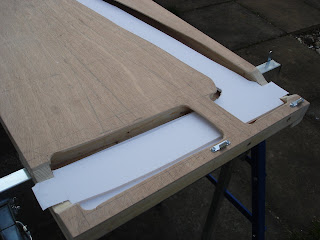Another Saturday morning, and some more progress. The trestles I purchased cheap on the Internet turned up, and I have assembled them. They are just what I had hoped for, and make a steady, sturdy support for the layout, and adjust from really low (for a layout) to a bit too high.

The cabinet makers dowels and catches also turned up in the post, and so the fiddle yard board now connects to the layout. My poor carpentry skills let me down a bit, and I have ended up with a little step to be dealt with when track laying, but it should end up OK.


I scratched my head a bit over supporting the far end of the fiddle yard. The catches and dowels would not survive the stresses for very long, but the weight to be supported at the end of the fiddle yard is not very heavy. I did not want to resort to a leg, as it would not be adjustable in height like the rest of the layout. There was not really anywhere to mount a diagonal brace to, easily. I had an idea about cantilevering somehow. I found a suitable piece of timber about 5 feet long, and attached small pieces of timber at each end (see photo above). The centre of the timber rests on top of the trestle, and the attached pieces of wood hook under the layout and fiddle yard at each end (see photo below). It seems to work, but I might add some catches to hold it in place.

So, that is it for this week. The layout needs a backscene board, and I will put a safety fence around the fiddle yard. I also want to build boxes to protect the layout for transport and storage. All this heavy woodworking needs to be complete before track laying starts. I had better start building some track to lay.





